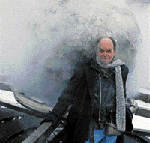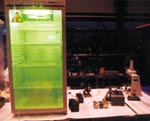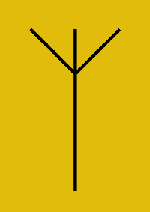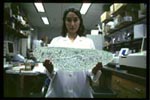|
| |
| |
|
|
| |
|
Pamela Ferdinand
wrote, "Davis eschews the art versus science argument, insisting
that he speaks both languages and could not possibly tear the two disciplines
apart in his own mind.", The Washington Post[3]
|
| |
| |
Background
|
|
Genesthetics:
Molecular Biology and Microbiology in the Arts |
|
| |
| Joe
Davis, is a research affiliate in the Department of Biology at MIT. He "is
an artist who has done extensive research in molecular biology and bioinformatics
for the production of genetic databases and new biological art
forms. He has also constructed sculptural installation
pieces, working with laser fabrication in plastics, steel, and stone; laser
teleoperator systems; and structural welding in mild steel. His teaching
experience in the MIT graduate architecture program (Master of Science in
Visual Studies) and in undergraduate painting and mixed media at the Rhode
Island School of Design has informed his artistic practice. He has exhibited
in the United States, Canada, and Europe at Ars Electronica."[2] |
| |
|
|
|
Recent works
include:
- Microvenus
(embeded artwork in a bacterial genome)
- Audio
Microscope (a microscope that translates light information into sound
allowing you to "hear" living cells, each with its own "aucustic
signature."
- Experiments
with how E. coli respond to jazz, and other sounds, with Andrew Zaretsky
- "the project is not too far afield from the work of the Demain
lab, which concerns itself more with microbiology and the production
of secondary metabolites such as antibiotics by bacteria. If the sound
waves prove stressful to the bacteria, the stress might result in increased
production of antibiotics, according to Zaretsky."[5]
- Putting
a map of the Milky Way into the ear of a transgenic mouse - "inspired
in this project by a children’s story an ex-girlfriend wrote eight
years ago. He has taken the map of the Milky Way and reduced that information
to sequence of 3,867 DNA base pairs. He has an agreement with Millenium
Pharmaceuticals to synthesize the DNA sequence in 100 base pair chunks."[5]
- "‘primordial’
clocks, his own test of theory that life spontaneously self-assembled.
To Davis, if life could assemble from simple molecules, so could clocks,
a much simpler system."[5]
- "For
seven years he championed a space shuttle experiment that would have
shot a 100,000-watt electron gun into the magnetosphere to create the
first artificial aurora..."
- "...ways
to make artistic use of high-voltage electricity and spacebound signals.
In the early 1980s, he drew up plans for channeling lightning bolts
into a pulsed laser of almost unparalleled energy and into towering
sculptures that would change the bolts' color and emit incredibly loud
tones..."
- "recorded
the vaginal contractions of ballerinas with the Boston Ballet and other
women, then translated this impetus of human conception into text, music,
phonetic speech and ultimately into radio signals, which were beamed
from MIT's Millstone radar to Epsilon Eridani, Tau Ceti, and two other
nearby star systems.
... and more.[6-11]
|
| |
|
From a
recent Nightline interview:
"What
kind of project would an artist-in-residence at MIT come up with?"
asked ABC "Nightline" Executive Producer Leroy Sievers. The
July 6 broadcast featured a report by Robert Krulwich on Joe Davis,
research affiliate in the Department of Biology and included a look
at Davis' paramecium fishing contraption -- deep sea fishing
equipment mechanically rigged to a drop of pond water. "[Davis]
comes up with all sorts of ideas that no one ever thought of before,
and then enlists the considerable brain power there to turn them into
reality," said Sievers. "I've always believed that part
of our job as journalists is to take people places they've never been,
and to show them things they've never seen," he continued.
"I guarantee you that you have never seen anything like this before."[4]
|
| |
| |
| |
|
|
|
|
|
 |
|
|
 |
|
a
microscope that translates light information into sound allowing
you to "hear" living cells, each with its own "aucustic
signature."
|
| |
|
|
|
|
|
 |
|
art
embeded in a bacterial genome
|

|
|
http://www.asci.org/ArtSci2001/index.html
|
| |
|
|
|
|
|
| |
|
|
|
|
|
|
| |
| |
| |
|
|





